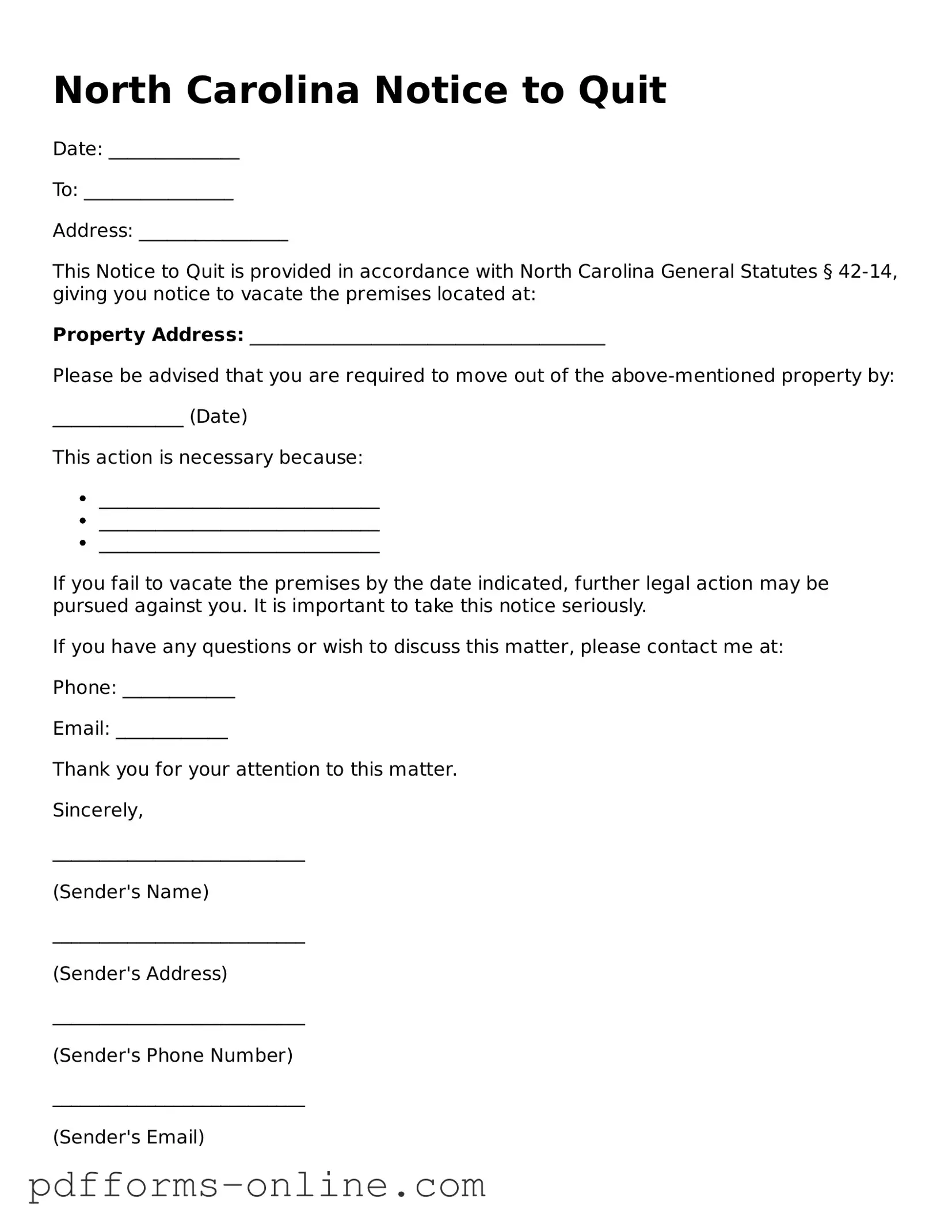The North Carolina Notice to Quit form is similar to the Eviction Notice commonly used in various states. Like the Notice to Quit, an Eviction Notice informs a tenant that they must vacate the premises, usually due to lease violations or failure to pay rent. Both documents serve as a formal communication from the landlord to the tenant, outlining the reasons for the eviction and providing a timeline for when the tenant must leave. The primary goal is to ensure that tenants are aware of their situation and the potential consequences of not complying.
Another comparable document is the Lease Termination Letter. This letter is often used by landlords to terminate a lease agreement at the end of its term or for specific reasons. Similar to the Notice to Quit, it provides a clear message about the end of the rental relationship and specifies the date by which the tenant must vacate. Both documents aim to clarify expectations and reduce misunderstandings between landlords and tenants.
The Pay or Quit Notice is also akin to the North Carolina Notice to Quit. This notice is specifically issued when a tenant has failed to pay rent on time. It requires the tenant to either pay the overdue rent or vacate the property by a certain date. Both documents emphasize the urgency of the situation and the necessity for the tenant to take immediate action to avoid further legal consequences.
In addition, the Cure or Quit Notice shares similarities with the Notice to Quit. This document is sent when a tenant violates a specific term of the lease agreement, such as having unauthorized pets or excessive noise. The Cure or Quit Notice gives the tenant a chance to rectify the violation within a set timeframe or face eviction. Both notices highlight the importance of compliance with lease terms and the potential repercussions of failing to do so.
The Conditional Quit Notice is another document that mirrors the Notice to Quit. It is typically issued when a tenant has committed multiple lease violations, allowing the landlord to set conditions for the tenant to remain in the property. Like the Notice to Quit, this document outlines specific actions that the tenant must take to avoid eviction, emphasizing the seriousness of the situation and the need for compliance.
The Notice of Non-Renewal is also similar in nature to the North Carolina Notice to Quit. This document is used to inform a tenant that their lease will not be renewed at the end of its term. While it does not necessarily imply eviction, it serves as a formal notification that the tenant must vacate the premises by a specified date. Both documents serve to clarify the end of a rental agreement and the expectations for the tenant.
The Move-Out Notice is another relevant document. It is issued when a landlord wants to inform a tenant of the need to vacate the property, often due to the sale of the property or significant renovations. While it may not involve lease violations, it shares the same purpose as the Notice to Quit in that it provides a clear timeline and reason for the tenant to leave the premises.
The Termination of Tenancy Notice is also comparable. This notice is used to terminate a month-to-month rental agreement, allowing either party to end the tenancy with proper notice. Similar to the Notice to Quit, it outlines the timeframe for vacating the property and ensures that both parties understand their rights and obligations in the termination process.
The New York Trailer Bill of Sale form is a legal document used to record the sale and transfer of ownership of a trailer in New York State. This form captures essential details about the transaction, ensuring that both buyer and seller are protected under the law. Proper completion of this form is crucial for a smooth registration process with the Department of Motor Vehicles (DMV). For those seeking this specific document, it can be accessed at documentonline.org/blank-new-york-trailer-bill-of-sale/.
Lastly, the Summary Ejectment Notice is akin to the North Carolina Notice to Quit. This document is part of the legal process that landlords may initiate to formally evict a tenant. While the Notice to Quit serves as an initial warning, the Summary Ejectment Notice represents the next step in the eviction process, outlining the legal grounds for eviction and the tenant's rights. Both documents play crucial roles in the landlord-tenant relationship and the eviction process.
